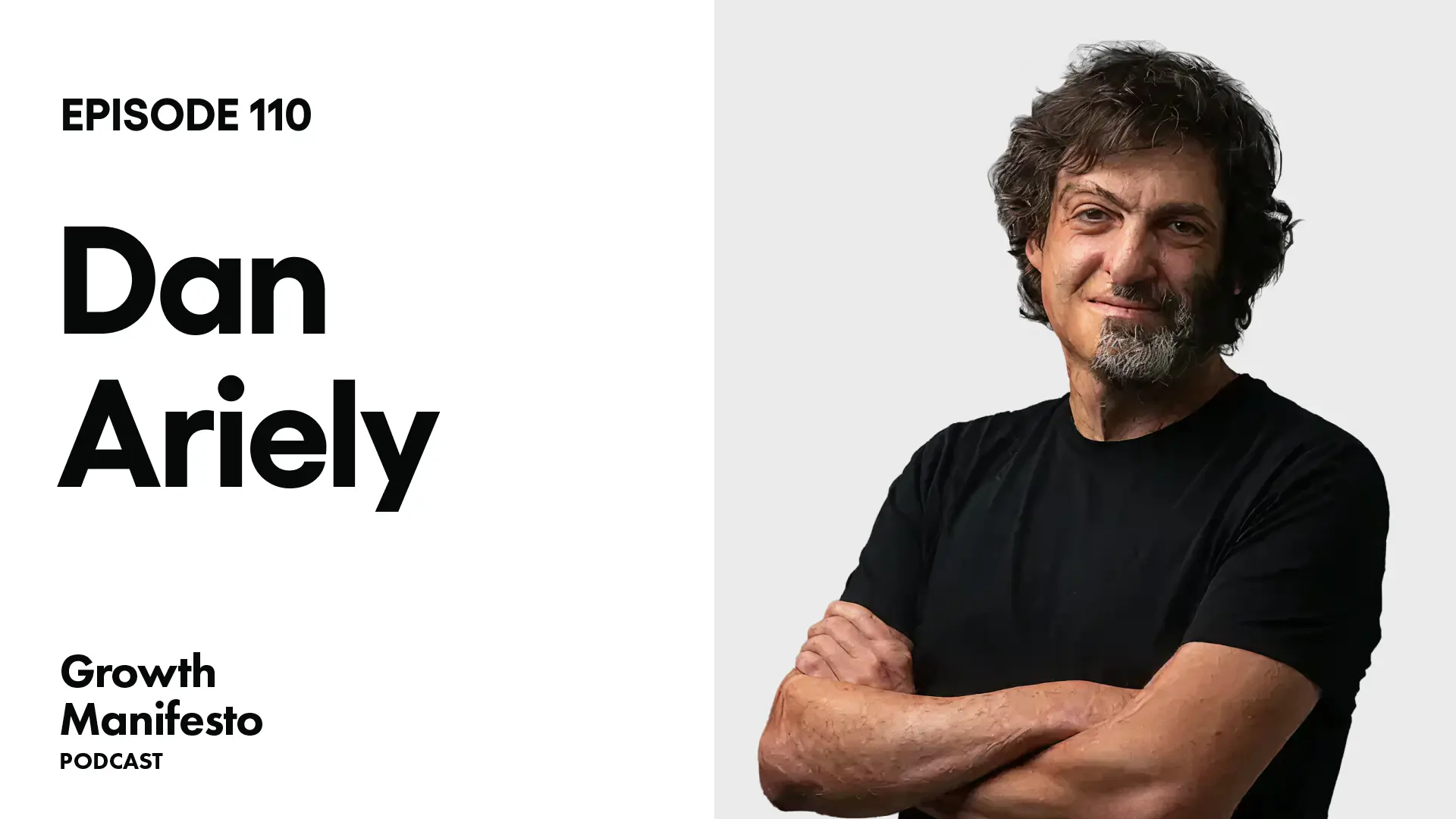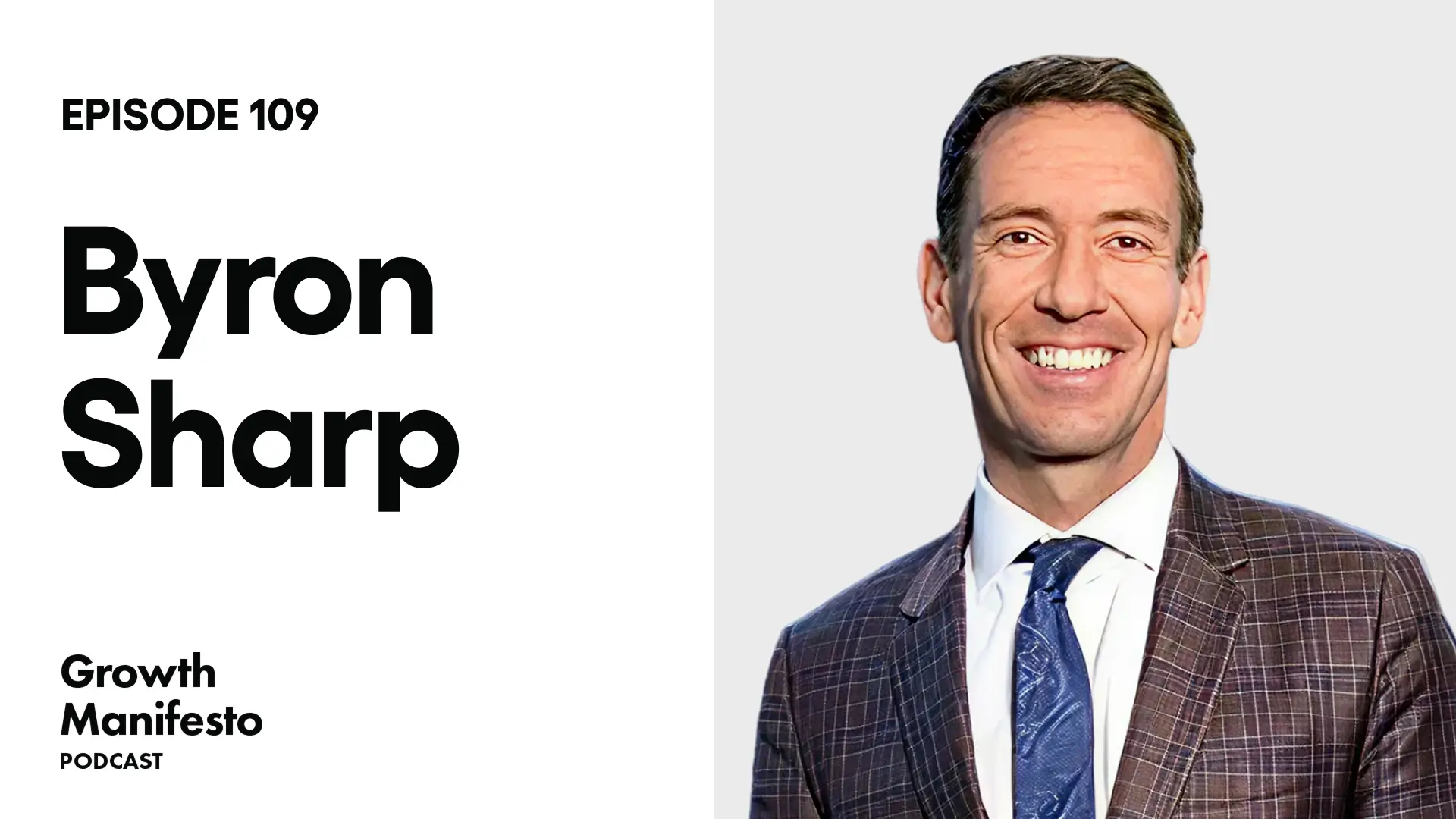How to use A.I. and Intelligent Automation to gain competitive advantage
This episode is with Pascal Bornet, author of the book Intelligent Automation. Pascal has more than 20 years experience leading digital business transformations, has founded and led the intelligent automation practices for Ernst & Young and McKinsey & Company, and has successfully led hundreds of intelligent automation transformations at scale across industries and functions. In this episode we talk about how to use A.I. and Intelligent Automation to gain a competitive advantage through streamlined operations.
LINKS
—
You’re listening to The Growth Manifesto Podcast, a Zoom video series brought to you by Webprofits – a digital growth consultancy that helps global and national businesses attract, acquire, and retain customers through digital marketing.
Hosted by Alex Cleanthous.
- YouTube: https://www.youtube.com/c/GrowthManifestoPodcast
- Instagram: https://www.instagram.com/webprofits/
- LinkedIn: https://www.linkedin.com/company/web-profits/
- Facebook: https://www.facebook.com/Webprofits/
- Twitter: https://twitter.com/webprofits
- Agency: https://www.webprofits.io
SHOW NOTES
- 00:00:28 Pascal Bornet’s introduction to the Growth Manifesto Podcast
- 00:01:35 What is Intelligent Automation?
- 00:03:42 All business processes can be automated according to Pascal and he breaks down how that is possible
- 00:10:00 Thinking, Execution, Vision, and Language are capabilities you can use to automate a business process and create a digital twin of a knowledge worker
- 00:11:58 How do you get started in automating your business processes?
- 00:14:54 The best way to automate and redesign your processes is to think about the end goal
- 00:17:00 How do you execute the automation process once the plans and steps are laid out?
- 00:19:47 People always comes first and are at the center of the business automation process
- 00:24:32 According to Pascal, you need to empower and incentivise your people to get them invested in the automation process
- 00:27:19 What are the reasons why some companies have embraced automation while others haven’t?
- 00:31:04 What are the benefits for companies that do business process automation and start it earlier than their competitors?
- 00:34:54 Intelligent Automation is an ongoing project and not a destination
- 00:37:36 How can Intelligent Automation be applied to any function in a company?
- 00:39:21 Can Intelligent Automation be applied to the creative and strategic side of business?
- 00:41:15 Intelligent Automation helps remove all the nitty gritty work to help you focus on what’s most important
- 00:43:53 According to Pascal, it is very important to think holistically when it comes to business process automation
- 00:45:12 Where do you see Intelligent Automation 10 years from now?
- 00:47:38 Pascal believes that the makeup of the Fortune 500 will change in the next 10-20 years
- 00:52:54 About Pascal’s book and his LinkedIn page
TRANSCRIPT
Pascal Bornet:
When everyone in the company has the opportunity, is empowered to build their own automations, to improve their own work using automation, and their ownership will change. And again, they feel they’re part of the transformation, they are part of the dynamic that is happening. They are not left behind.
Alex Cleanthous:
Today we’re talking with Pascal Bornet, who’s the author of the book, Intelligent Automation. Pascal has more than 20 years experience leading transformations and has found and led the intelligent automation practices for Ernst & Young and McKinsey & Company, and has successfully led hundreds of intelligent automation transformations across industries and functions at scale.
Today we’ll be talking about how to use intelligent automation to gain competitive advantage and drive business growth. Just quickly before we get started, make sure to go ahead and hit that subscribe button, so you get the latest episodes as soon as they’re released. Now, let’s get into it. Welcome Pascal.
Pascal Bornet:
Thank you Alex. Thank you for inviting me.
Alex Cleanthous:
Yeah, it’s my pleasure.
Pascal Bornet:
Very happy to share my passion, before it’s Sebastian… that pushed me and my co-author to write this book, and I’m happy to share about it today.
Alex Cleanthous:
Well, it’s definitely a very contemporary topic. There’s a lot of lack of understanding about the whole industry, right? And so I think this is going to be a fantastic discussion to really understand what companies can actually do and how to get started, right? But let’s jump straight in, what does intelligent automation mean and what challenges can it solve?
Pascal Bornet:
Good and important question. We all hear a lot about artificial intelligence. It became a buzzword that would say over the last two years. And we use it for science fiction as well as companies, and people don’t understand how to pragmatically in reality use it, and get the efficiency gains that we are working for.
That’s the reason why we haven’t called it artificial intelligence, but intelligent automation, intelligent automation really refers to the use of different types of technologies to automate some of the work that is currently being done by people. The official definition is, it’s a combination of methods that includes people, organization, data, processes, and technologies. That includes robotic process automation, machine learning, natural language processing, computer vision, and much more.
Putting or combining those technologies and concepts together, we are able to automate end-to-end processes that are currently being done by people. For example, purchase to pay is an end-to-end process that each and every company around the world has to perform to basically identify vendors, procure goods or services. Then identify if we’ve received those services and goods in the right quantity, quality… And if we can then pay them, those vendors.
Alex Cleanthous:
Okay, so that’s an example of a process that can be intelligently automated. Is that right?
Pascal Bornet:
That’s an example of a process that is definitely currently being done by people. And that can be automated. All the processes can be automated. I haven’t seen a process that can’t be automated, not yet.
Alex Cleanthous:
Let’s jump on that. This is really, really important part of it, right? Because in your book, you talk about automating the work of the knowledge worker, which in the past would be very, very difficult to do, right? Because it’s the thinking behind it. It’s all the parts. It’s becoming easier to automate the manufacturing industry, and there’s examples of how Amazon has warehouses that are completely dark, that everything is just completely automated.
But what we’re really talking about is to kind of automate the process of the knowledge worker, right? And so you just said that you haven’t seen a process that cannot be automated yet, right? And so what does that mean though? Does that mean that because everything in a business is usually processed, right?
A lot of companies have processes, the processes are between people, there are decisions that are being made. There are things that are happening, how does this solve all the processes? Because it seems like you get that invoicing core, right? There’s steps in that, it’s just about numbers really and checking things, but how does it do everything else?
Pascal Bornet:
Yes, very good question. Let’s get back to our example of purchase to pay.
Alex Cleanthous:
Please.
Pascal Bornet:
I think that’s universal, every company does it. We said that it’s the process to start with, you know that you need to buy the goods or service through a vendor. And the starting point is usually being done leveraging machine learning, to forecast what will be your needs. And especially in big companies you can think of manufacturing companies when they need raw materials, for example, that’s a critical process to get their manufacturing and production activities going.
Forecasting activities, that’s the number one process of this purchase to pay end-to-end process, is leveraging machine learning to predict what will be the needs of which product do we need to buy to which vendor, for which quantity for when? That’s the first starting point.
Alex Cleanthous:
The first step is not even simple. The first step is to leverage machine learning, to figure out what we need.
Pascal Bornet:
Exactly.
Alex Cleanthous:
The decision is being made, it’s not just a process, it’s the decisions in the process that we’re talking about as well.
Pascal Bornet:
Exactly, exactly. The way I define a process is a sequence of tasks and those tasks can be cognitive tasks, like making a decision, like digesting information to predict or to make a decision, or can be manual tasks or can be tasks that are related to what we see or to what we hear or what we say.
Alex Cleanthous:
And so —
Pascal Bornet:
Let’s go step by step.
Alex Cleanthous:
Yeah, let’s go step by step, and I’m going to ask you to break it down really simply for me. I’m going to ask you lots of questions, so please, step one, machine learning to figure out the decisions.
Pascal Bornet:
Exactly. And to figure out the decision of buying, which product to who, when, how much. You take this decision, and this means that you need to generate a purchase order. And very often you will use a workflow platform that will help you to connect with the vendors and have them go through this process that goes from step one, you get the purchase order, step two, you get all the answers from the different vendors.
And step three, you will have a first review process with selection of top three vendors, for example and finally get to the selected vendor. Through this workflow platform that belongs to… In the book, we talk about four capabilities that are basically four groups of technologies that help to mimic what the knowledge workers are doing in their work.
The first one was using machine learning, it was thinking and learning. So that’s the first three. Now we are talking about a workflow platform that helps to route the data, collect approvals, store the data, and help and support the work flow of decisions between people. That’s the execution capability.
Then let’s say we select a vendor, and then we receive the goods, and now we need to pay them. So we receive their invoice. And we receive their invoice, unfortunately, not all companies have an exchange of data as you know. You might probably receive a paper invoice, but even you might receive it by mail or a PDF of the invoice. In this case, you will need first of all, computer vision to help you read this invoice automatically.
That’s the third capability which is about visions basically, that’s what we do with our eyes usually. And now machines are doing it automatically thanks to computer vision. And then you need to probably read the email and probably interact with the vendors if there is an issue on the invoice, for example, and here is coming language capability, which is currently being done by virtual assistants that are leveraging natural language processing.
And finally whenever you’re happy with the amount of the invoice, you got your goods in the right quantity, quality, you want now to perform the transaction, to pay those vendors. And this is a very transactional activity that can be simply automated using robotic process automation, for example. And this is the coming back to the execution capability.
Alex Cleanthous:
Got it. And so these four areas are the thinking, the execution, the vision, and the language. So those four areas are the things which are required for every automation? For every intelligent automation, is that-
Pascal Bornet:
No, no, that’s not-
Alex Cleanthous:
Not everyone. Okay, sorry, please correct me. Like I said, I’m going to ask lots of questions-
Pascal Bornet:
Yeah, yeah, very good.
Alex Cleanthous:
To see if I’m understanding it.
Pascal Bornet:
Those other capabilities you can use to automate a business process. But sometimes one, two or three of them are sufficient.
Alex Cleanthous:
Oh, okay. So it’s going to be a maximum of four, but it could be three, it could be two, it could be one. Is that right?
Pascal Bornet:
Correct.
Alex Cleanthous:
This is really good, right? Let’s okay. Sorry, please.
Pascal Bornet:
Yeah, very importantly. Why those four capabilities? Those are the capabilities that we as knowledge workers are using to perform those processes. Either we read a document, either we talk with someone, either we press a button to send an email, or we think and learn using data and providing some insights and predictions.
Alex Cleanthous:
Got it, got it. That’s a very important point is that this is an example of how someone actually operates, right? This is the work that’s happening, is thinking, it’s looking, it’s doing, and it’s speaking, or writing, like that’s the parts, right?
Pascal Bornet:
Yes, if you want, we are kind of creating a digital twin of a knowledge worker. That’s another way of explaining it. We are creating a digital worker that is working hands-in-hands with the human worker.
Alex Cleanthous:
Sure. And I’m sure that’s scary for some people, but I think there’s something on the other side of that. So we’ll get to that a bit later, but just to understand the process. Now you’ve got these four areas, you could use all four for a more advanced process, or you could use fewer amounts, right? Now, when you explain it, machine learning, you have OCR, there’s ICR, there’s biometrics, smart workflows, intelligent chat bots, sentiment analysis.
You’ve got all these things that sound so complicated, right? And for someone who’s saying, “Listen, I really want to automate some things,” right? “This is something I can say to be extremely valuable for the future, it has some competitive advantages, obviously, because it cuts down time, it cuts down issues, it cuts down errors, but how do you get started in this?” How do you say, “Okay, I get it, there’s these four steps, right? Machine learning, let’s start there.”
What does that mean from an execution perspective? Because I know there’s platforms out there, it sounds complicated, but it can also not be as complicated as it sounds. Can we just talk about each of the parts and just kind of understand what’s involved in that, in just getting started. I mean, obviously it can get very advanced, right? But just to get started.
Pascal Bornet:
That’s a critical question. And the answer is, think business first. Technology is just a tool, just something to help. What’s important is what we need. I’m currently performing this process and onboarding clients in the bank. When you want to get a bank account open and you need to produce a lot of documents. How can I get those documents?
How can I make this process of onboarding of clients more efficient, more pleasant for the customers, more pleasant for the employees that are working in the back office. It’s just about this. And to make it easier for the clients, you would think of making it fully digital, for example, so that it’s a workflow online that can be done from your sofa. You can upload your documents.
Everything is simple, if you have a question, you have a virtual assistant to help you. In the back office of the bank, usually you have employees receiving those documents, typing those documents, from image to a digital form. I mean, who wants to do that eight hours per day? I mean, I wouldn’t wish this for my worst enemy.
It’s about helping those people in the back office, having an optical character recognition tool, as you mentioned. Basically computer vision that helps to read the document, extracts the information that we need, and directly processes it into the transactional system that it needs, for example.
Alex Cleanthous:
And just put that part there, I’m just trying to break it down. We need to create the business process and have a look at it. And so I think the first part is rethinking the process, right?
Pascal Bornet:
Correct.
Alex Cleanthous:
It’s not taking the same process and just trying to automate it.
Pascal Bornet:
Exactly.
Alex Cleanthous:
It’s rethinking it, right? What are the steps? Please.
Pascal Bornet:
That’s definitely a very important step, I would say it’s maybe the second one. The first one is to identify what the business needs. And where are they the strongest, because at the end of the day, everything can be automated, but some of the processes have a high value of being automated, a higher value than others.
And I mean, from my experience, if you have a look at the different processes, you can automate in a company and it can go from few hundreds, five hundreds to thousands. If you really go to identify all of them, you see that only 5% of them, roughly 5% of them will generate about 70% of the total value you can generate by automation.
It’s all about focusing on those ones first. And as you say, then those processes we don’t want to just copy what is being done today, because we know it’s not efficient, so let’s rethink them completely. And the best way to rethink them, redesign them, is to focus on the output, the outcome, what do we need at the end.
And the onboarding process that I just described, at the end, I mean, the bank needs to be satisfied with all the criteria that need to be checked for clients to manage regulation, but also to manage the risk of the bank. What do we need at the end? That’s what we need. So now how do we get all these in an automated way? It’s starting at the end, that’s the end, that’s the second step.
Alex Cleanthous:
And so you start at the end, you create the steps, right? That’s all good. And we can all create the steps in some type of wire framing software, or even on a piece of paper with squares-
Step by step, right? Up on the whiteboard, if people have any whiteboards in their home, more outlook. This office is open again now, so maybe in the office, but it’s created, so you’ve got the steps and now you start to think, all right, this step requires some OCR, this step requires machine learning, this step requires some language processing, right?
Is that a developer which you need to hire to execute on that, is that how companies should be thinking about this? Is it like, all right, I now know the parts and I know the challenges, who can help me implement these challenges? Is it creating a team internally? Is it finding a partner that can help you? What are some of the ways that the companies are approaching that part of it? Because I can see that that would be the biggest challenge. I could be wrong to declare that.
Pascal Bornet:
I think when you get there, meaning when you get to a redesign process and you are clear on what are the steps that are necessary to get to your outcome, it doesn’t need to be translated yet into what is the technology to help. But just that you need this, this, this, that. I think 70% of the work is done. That’s the most important.
Then it’s about bringing a solution architect or someone who knows, doesn’t need to be a very technical person, someone that knows that to achieve this, you’ll need these types of technology to achieve this type. It can be one solution architect, it can be also, and I prefer the solution to have around the table, different talents coming from teams that usually are functioning in an isolated manner in companies.
Most large companies have a team for robotic process automation. A team for customer service, which is dealing with chatbots. And another team that is about data science and machine learning. It’s really about bringing all those standards around the table and redesigning together and identifying which technology will we need when, where, and identifying how we connect those technologies together?
Alex Cleanthous:
Basically you do need somebody that is technical and has a technical understanding. And so you mentioned a solution architect that could be internal, that could be a partner. And then, but you want to have a conversation with all the teams involved in the process to get their feedback, and their thoughts on what should happen, right?
Pascal Bornet:
Correct.
Alex Cleanthous:
Now, before you say we can automate every process in a company, right? And most companies, it’s just a collection of processes, and then some sales and marketing and brand. You know what I mean? Everything else seems to be like if it’s a service, it’s like a knowledge service, right? If it’s a product, it’s manufacturing that can be covered, but through robotics and so on, right?
But how do you get the buy-in, what are those people then going to do if they’re going to help you create… I was watching some show and they were making a joke about AI. There was a bot there, and they were like, we need to train the bot to do our job to replace us, and it was just a comedy show, but this is like a thought that people have. If we are helping create this thing for the process, what about our jobs? What does that mean for us? And so how do companies kind of approach that challenge or that conversation let’s call it?
Pascal Bornet:
And it’s a critical component of a successful transformation. And when we explain the different capabilities in the book, when we explain the framework to successfully achieve such a transformation, people come first, people are in the centre. I’m used to saying that, those transformations are made by people for people. If you miss the people aspect, you miss the project.
When we talk about people, we talk about two types of people. One is management, and management like CEOs, C-levels, I mean, their involvement, information, education, and sponsorship of the transformation are critical. I’ve never seen a company succeeding in this type of transformation without this. That’s the critical component.
It’s about bringing them to this level and helping them to build their vision, and to build their vision, we need to help them understand what are benefits, quantitative, qualitative, what can be a typical roadmap. And they will be able to understand the benefits, how much investment they’re already… That’s the first but critical component of people.
The second now, all the other employees, and they are extremely critical as well. Again, there is no transformation that happens without people. You need to inform them, educate them, that’s one of the reasons we wrote the book. That’s to create this tool that is necessary for this transformation to succeed.
When you’ve informed and educated everyone in the company, you need to go further; it’s not enough. You need to involve the people in the transformation. Today, and more and more the technologies are getting more user-friendly, you might have heard about low-code, no-code technologies. The philosophy behind that is that everyone in the company is a potential developer, citizen developer.
And I think it’s dimension is extremely important and needs to be leveraged by companies today, for two key reasons. When everyone in the company has the opportunity, is empowered to build their own automations, to improve their own work using automation, and that ownership will change, and again, they feel they are part of the transformation. They are part of the dynamic that is happening, they are not left behind them.
That’s the first thing. And the first thing is, of course, because you have more hands working towards implementing the transformation. Of course, you go faster and you can do it bigger. And the second and most important thing as a result of this is, because the ownership of each and every person in the company is changing and moving towards this transformation to succeed, the mindset, the culture of the company changes into more digitalization, more automation. People understand and are willing, and the mindset is changing, the mindset is so important, the culture is so important.
Alex Cleanthous:
Again, I’m going to try to simplify it so I understand it. You need the management to be on board because you’re solving the business challenges, and it’s not going to happen without the management on board, right? But then from a staff perspective, from a team perspective, they need to be part of the journey. What you’re suggesting is to include them in the conversations about this others happening.
But maybe an easy way is to encourage people to spend some time on some of the low-code platforms or the no-code platforms, just to have a place, see what they can automate themselves, those kinds of things, and then share that upwards. Kind of like the Google company, but I mean, they’re a bit more advanced, right? But where everybody gets their 20% time to spend on projects, something different, something else. Is that kind of a way in? I’m not saying spend 20%, but just give people the opportunity to just play around, to see what they could automate themselves.
Pascal Bornet:
Definitely, that’s a great point. Empowering the people to do things is a good starting point, but we need to go further. And the next step is about incentivizing the people to do that. I’ve seen many ways to incentivize people doing this, from contests that give rewards to people, rewards to people in the shape of publisher, in the shape of MBA courses offered, in the shape of, I mean, it can be many things. But most importantly, it should be part of the KPIs of anyone.
Alex Cleanthous:
Got it.
Pascal Bornet:
There would be the key performance indicators of each and every employee.
Alex Cleanthous:
I like that. This was the quickest — Is there a low-code or no-code platform that you know of that is like, “That’s really good, just save yourselves time, because there’s so many out there now,” right? But is there one which you would recommend to people that you’ve experienced with it that you think they’re really good at?
Pascal Bornet:
That’s a difficult question because it’s like machine learning, it’s everywhere now. I think each and every tool now, each and every technology on the market now is making their configurations easier by having user-friendly screens, drag and drop type of functionalities that make it easier for everyone. Each and every technology is following these trends.
Alex Cleanthous:
Sure, sure. Let’s jump to the reasons why. Now, the first part of this podcast has been actually talking about it, and it sounds complicated. I’ve tried to simplify the thinking behind it, but it’s not simple, right? And the fear around the replacement of jobs or having conversations with the team that might be difficult, right?
And so they’ve got all these kinds of obstacles in people’s way versus the future benefits of it, right? I could just continue to run my company or whatever it is and my department, and that’s just going to keep running, I’m comfortable. This is going into a place of uncomfortable, right? We’re going into a place that we don’t know, we don’t understand, probably going to take a bit of time, we’re not going to get it right the first time.
There’s going to be lots of conversations about this, right? What are the reasons why somebody should do it compared to not doing it? What does it do for the companies that have embraced it versus the ones that haven’t? What does a two to five year trajectory look like?
Pascal Bornet:
No, that’s a good point. That’s exactly why incentivization is very important, to push people to act in the direction that is needed for them and for the company. And when I talked about the action to the people that are necessary, I talked first about information and education. What does it include?
That includes not only what are those technologies and what you can expect from them, for you as an employee, but also for the company, but also being very transparent and what does it mean for each and every people’s role? And some rules, definitely, those people that we were talking about that are transcribing an image and typing into a transactional system, eight hour per day, those people definitely will have technology to do their work.
And as we said, nobody would love to do that at any time. It’s about giving transparency to those people, and telling them in this specific example, technology will help you now do the job that you were doing that was very transactional. Do you agree with that? The people will say yes. And now we’ve thought about refocusing your time on more value added activities. For example, why don’t we help you now to understand the data that you use to type and work on these data so that you can do some analytics, create some insights from it, and we will teach you how to do that.
Alex Cleanthous:
That’s part of it.
Pascal Bornet:
This person will go from the stage of copying data, the whole day without even thinking to a role where this person we have to think, and will have to make some decisions, will have to bring some insights. And from a survey that psychologists have done, satisfaction and happiness at work happens when people have to take even small decisions but decisions, and create some insight, create something from the-
Alex Cleanthous:
What about-
Pascal Bornet:
Psychology point of view, it works. It’s not that science proves it.
Alex Cleanthous:
That’s from a staff perspective, right? Now, from a management perspective, what happens if you don’t kind of implement something like this and your competitor does? What happens if you sell as the managing team, it’s too hard right now, let’s come back to it later, right? And then at the same time, a competitor of yours starts now and starts to take advantage. What does that gap start to look like after 12 months or 24 months of just waiting to start this journey?
Pascal Bornet:
It’s a very good point. The first to start, will be the first ones to learn from it. And of course, will be the first one to collect the benefits from those technologies, or to benefits for companies-
Alex Cleanthous:
For companies that do it, what are the benefits that companies get?
Pascal Bornet:
It’s across the board, productivity improvement, let’s start with that. 20 to 60%, that’s-
Alex Cleanthous:
That’s a lot.
Pascal Bornet:
What we’ve seen on the market. Meaning an improvement of net profits. It’s really that’s what’s driving the company’s health, on top of these customer experience improvements, and we’ve seen percentages of NPS scores. Satisfaction of customers increasing by 50% after such a transformation. Employee satisfaction, we’ve seen teams suffering from a high turnover of teams like 20, 25 to 30% of turnover because the work was very transactional, and people were not happy to do that.
To teams that are performing well with still being in a transactional environment, having 10% turnover, so really increasing employee satisfaction. And I think those are four companies, those are the critical ones. I mean, you have also the improvement of quality, you have also the improvement of quality that means better outcome of the work, but also less errors. And somewhere else can cost very much, especially when we talk about the finance department, for example, I mean, yeah, those are, those are the ones that come to my mind now, you cannot release all of them.
Alex Cleanthous:
It seems to be that the advantage happens, probably going to be an investment in the first 12 months, right? But every company wanted to make that investment. So then if you’re the company that does it first, and you start to automate some of those processes, you start to reduce your costs, you start to improve quality, you start to innovate faster. Just starting is the hardest part, but once you get to a point, now all of a sudden you start to snowball. And at that point, the competition is going to find it very hard to keep up, right?
Pascal Bornet:
Exactly, and so-
Alex Cleanthous:
And so you don’t want to be that competitor for that company.
Pascal Bornet:
Correct.
Alex Cleanthous:
You want to be that company that the competitors are now struggling to catch up with, right?
Pascal Bornet:
Exactly, you just forgot one thing, the increase of revenue as well, because a customer being more happy-
Alex Cleanthous:
Yeah, so you get more market share. It’s simpler, faster-
Pascal Bornet:
Exactly —
Alex Cleanthous:
And so I’m just trying to be really clear for the listeners that this sounds complex, but this is where the world is going, right? And so no matter what you think is going to happen versus the stuff that’s actually going to happen, this is going to happen, right? If you put your head in the ground and just hope that you’ll be able to survive in 10, 15 years, there’s a lot of disruption happening.
But outside of that, your sure competition could be investing in this and you don’t even know yet, because it takes a bit of time, right? And so I guess, it’s just a call to action to really start to think about how you can change your organization for 2020, 2024, 2025.
Pascal Bornet:
Yeah, it’s a starting point, but we don’t know when it ends, because I mean, I like a quote, which is, “Intelligent automation is a destination,” not as an ongoing project, not a destination. It’s not a one off project, you need, basically, one of the key recommendations we have and what the… Companies that have succeeded have been the centre of excellence that not only helps to drive the implementation of the roadmap of those concepts and technologies, but also that constantly watch what is under market without the new capabilities coming that we can use to generate more benefits. It’s a never ending game.
Alex Cleanthous:
But I think what’s important for everyone to note, because that sounds like, wow, it sounds like forever, which it is. But it’s only hard in the beginning before you start to see the benefits, once the benefits start to come through, it means you would have already figured out how to automate a process effectively, right? All of the things that we’ve just spoken about in this podcast, you would have figured out.
At that point, it’s all about, wow, now how do we focus our resources to really get that next win, and the next win, and the next win. And it really starts to snowball. From a thinking perspective, from a mindset, it’s just to get the first successful automation completed and put kind of into action, right? From there, you’ll be like, “Okay, wow.” And everyone will say it and be like, “Okay, I understand what they’re trying to do now, with this crazy intelligent automation thing,” right?
“Now I get it, now I don’t have to check invoices against the spreadsheet, against the CRM, against the Slack Channel, to the other thing and another something else.” And 19 people have to touch a specific invoice because of the confusion around who said what, to what person, about what? That’s just one example. You said it can be done for every process, can it be done for marketing? Can it be done for… How could it be done for marketing, since this is like a marketing podcast, right? How does this apply to marketing?
Pascal Bornet:
To answer your question, can it be applied to any function in the company and any company? The answer is yes it is. And we’ve demonstrated it in the book at the end of the book we have, I think it’s more than 100 of collecting more than 500 business use cases. And we’ve ordered them by function and by industry. Marketing is one of them, but you have human resources, supply chain, finance, you name it.
In terms of industries, we have banking, telecommunication, governments, and yeah. We’ve demonstrated it through this. And to answer your question for marketing, for example, we have anything that is related to, first of all, understanding the data and creating insights from this data. Let’s think of what you can forecast, what you can plan. Forecast of sales, forecast of understanding of a market, segmentation of a market, segmentation of competitors, of demands, and monitoring of marketing actions, prediction of the impact of marketing actions.
Alex Cleanthous:
This is just going to be me saying if I understand it, or even just asking a question, but it sounds like it can do a lot of the heavy lifting around the work that’s already happening, right? In terms of data, and insight, and forecasting, and all that type of stuff, or the stats or the checks and balances and all the things that are happening.
What about from the creative side of things, the coming up with concepts or creating a strategy, right? Strategy can be very hard, because you have to have lots of insight and lots of data and all that. Is it that kind of support for that process? Or can it actually do that process?
Pascal Bornet:
No, for creativity, for critical thinking, for relationship with people, there are a few capacities that technology is not yet able to achieve.
Alex Cleanthous:
That’s really good for all as marketers by the way, who like to think and all our consultants and strategists and all that type of stuff.
Pascal Bornet:
And I think it’s going to stay like this for a while like this, and I don’t see technology being able to perform such high level thinking activities yet. It’s about thinking out of the blue, critical thinking strategy, design, pure creativity, and relationship with the people. I mean, for the time being, we have virtual assistants, but they still lack a lot of-
Alex Cleanthous:
— around it.
Pascal Bornet:
Of components. Yeah. I mean.
Alex Cleanthous:
Empathy, can provide-
Pascal Bornet:
Empathy for example-
Alex Cleanthous:
These things.
Pascal Bornet:
Is an important one, exactly, exactly.
Alex Cleanthous:
What we’re really talking about is that, there are core things that people do within companies, right? But then there’s a lot of stuff that happens between departments, or functions, or supporting the work, or the thinking, or the critical thinking, or the creativity, or whatever is the campaigns. And so what intelligent automation does is that, it just removes all that stuff, so you can just focus on the most important.
Pascal Bornet:
Exactly, we did some research around this that we present in the book. Out of all the scope of work tasks that are being done by people in average in companies, more than 30% of those tasks can be eliminated.
Alex Cleanthous:
Just eliminate them.
Pascal Bornet:
They think of unproductive meetings, unproductive emails, we’re spending a huge amount of time on this. Second, more than 30% of those tasks can be automated, and there is more logistic transactional stuff that we are doing in our days. And the remaining 30% should be augmented by technology. Again, we should keep them, they’re creative tasks, these are strategic components, these are decisions.
For the time being we can’t automate, again, I don’t believe we’ll be able to automate them for a long time in the future. And where we need the clinician to help us to go beyond. Think of when we talk about augmentation, think of a doctor, a medical doctor who usually spends hours reading x-rays to understand if there is a tumour on it. Thanks to technology, these doctors are augmented, is capable of making decisions in just a few seconds, which have huge impacts on people’s lives.
Alex Cleanthous:
Yeah, sure. That’s really, really, really, really interesting. For the listeners, start to prioritize the business challenges, right? From there, look at potential solutions, from there find a partner, a solution architect, or just somebody internally or whatever else it is. Then from there we have a round table to kind of create the process, and execute on it, and just try to focus on one thing, right?
If it was to start to see the benefit from it, are there some easier places to start than others? If we can just as for example, the machine learning part, does that maybe to make it a bit easier, or do you always need machine learning? Is that the big part about it? It does leverage AI to make the decisions, is that part of this?
Pascal Bornet:
Can I automate the end-to-end process? But some of those parts in the process would remain manual.
Alex Cleanthous:
No, it’s more-
Pascal Bornet:
And the issue with that is, when scaling the process from one decision to 100s of decisions, then you still have this bottleneck of, ah, that’s done by people, that’s not scalable, or you need to hire, you need to hire. And then when your business is slowing down, oh, you need to fire, you need to fire, and then you need to hire the 30 minutes. It’s very important to think holistically, have the big picture first.
Alex Cleanthous:
Big picture first.
Pascal Bornet:
Yes, and don’t keep a task manual in the middle of an end-to-end automated process. That becomes your bottleneck, your weakest point.
Alex Cleanthous:
Where do you see intelligent automation in 10 years from now? What does that look like? What does the world look like in 10 years from now with so much advancement across so many areas?
Pascal Bornet:
I think the pandemic has been, of course, a terrible event, but if we have a look at the positive aspects, it has pushed the companies to digitize themselves, to automate themselves. The companies that have not been able to collect their cash online, to sell their products online, to motivate their employees remotely, either they are still surviving because of subsidies from the government or they just died.
And so back to your point earlier, it used to be a competitive advantage of using such concepts. Now it’s a survivor, it’s an inductive for the company. I see the future being stronger and stronger and with more and more use of those concepts and technologies, and those concepts and technology sophisticating in time, so that they allow us to scale those transformations.
Today, this is what we are lacking. According to Deloittes, the good news is that more than 50%, 5-0, 50%, half of the companies around the world have started their journey in one way or another in intelligence determination. But the bad news is according to making only 15%, so 1-5 have been able to scale it. Basically have been able to implement it across more than three divisions or functions. The holy grail is about scale now.
Alex Cleanthous:
Scaling. And so if you’re not one of those companies, that’s something to think about, right? It’s something to be concerned about. I mean, at least the 35% that haven’t scaled it yet, it’s just yet. They just haven’t scaled it yet. I mean, they are still investing in it and they’re still trying to scale. And I think the other thing is that things always change, companies change. I think you said somewhere in the book, correct me if I’m wrong, but the makeup of the Fortune 500 will change over the next 10, 20 years. Could you just talk about that quickly?
Pascal Bornet:
Yes, yes, yes. It’s coming from a that the predictions are that, I mean, basically the life of companies, the duration of company is getting shorter and shorter. More and more companies die every year, but also more and more companies born every year. And the predictions are that’s more than half of the S&P 500 companies will change over the next 10 years.
The question is, are you part of it or not? And to try to answer this question, are you part of it or not? We’ve analysed data from a large sample of companies to understand what makes them different in their adoption of intelligent automation. One of the key criteria, the key indicator we used is the benefits created by employees.
That really shows you how much you can produce as benefits by human resources. The higher, of course, the better, the higher meaning, the better you use your home your human resources, and certainly the more you’re using automation. And we found out that the key driver that explains this is the age of the company. The older the company is, the less it’s going to use automation, and the more likely this company is to die soon.
Alex Cleanthous:
Sure.
Pascal Bornet:
And to explain this, our finding is that, all the companies have too much history, too much legacy. It takes too much effort, it’s a huge amount of effort to transform themselves. And we are talking about significant changes that impact everything in an organization, processes, people, data. The analogy to bring all these from where they are today, to where they should be tomorrow is huge compared to starting a new business. Brand new in, I mean, leveraging, straight from scratch those new concepts, leveraging those new technologies.
I mean, we see more and more companies, all those companies changing themselves, not by trying to change the legacy business, but by trying to create a whole new business close to the legacy one, see if it works, make it small, like a startup that is close to the, let’s take a bank, an old bank, old retail banking agencies and so on.
This company creates a new startup and the startups creates the business online, completely online and brings more intelligence and automate and digitalize. And then we see two behaviours, either very often these new businesses will work very well. Either the company uses this new business to say to the legacy business guys, look at this, this is what we need to achieve, so let’s get inspiration from it.
It’s easier for the people because it’s part of the same company, it’s part of their colleagues to infuse this new way of thinking and the new. That’s one. And the other behaviour is to kill the legacy slowly, kill the legacy and slowly grow the new business.
Alex Cleanthous:
Sure, things are going to change and things always change. That’s the one constant, is that there is change that’s been stated everywhere. But from a company perspective, I do like the thinking around, look, if it’s too complex to change internally, create a spinoff or do one of them. Either do one or the other, but don’t just hope that things are not going to change, because that’s what happened to Kodak, right? I think it was Kodak.
That’s the best example of what happens if you don’t start the journey of where everything is going, anyway, you may not know the outcome, but the journey, like what you said earlier, that’s where it is. It’s in the journey, and you just have to get to the first little checkpoint, the first thing, the first execution, right? Until you start to see the benefits.
Pascal, it’s been so good talking about intelligent automation with you. For the listeners, you must buy his book. It’s on Amazon, it goes into detail across everything. It talks about thinking, it talks about the different approaches, it talks about the different technologies. It’s got examples, it’s got societal impact, it’s got the business impact, it’s got case study, after case study, after case study.
If you’re serious about protecting your company into the next decade, you need to buy his book. The other one is that you got to follow him on LinkedIn. He’s got one of the best LinkedIn content sharing processes. I wonder if it’s automated, I don’t think it’s automated, right? But it is very engaging, it is very thought provoking. And it’s just fun to look at.
I think I just shared something I saw from you yesterday about the before the remote work versus after remote work, and your one already had 5,000 shares and likes. I shared it, it’s already gotten like 50 from me. That’s how good your content is. For people who are listening, you’ve got to follow him on LinkedIn, and you have to buy this book. It’s going to be the best investment that you make protecting the company for the future.
Alex Cleanthous:
Pascal, again, thank you so much for coming on the podcast today. This has been extremely enlightening and I hope all of the listeners, and the viewers have found it the same. Thank you so much.
Pascal Bornet:
Alex. This was an honor, thanks a lot for inviting me, and a great discussion, really like your challenging way of questioning.
Alex Cleanthous:
Well, I’m just trying to figure out how to do it, right? I’m trying to figure out how the companies do it in a certain way.
Pascal Bornet:
Very fancy, very fancy, I like it.
Alex Cleanthous:
Yeah, cool. Thanks so much, Pascal. We’ll talk soon.
Pascal Bornet:
Thank you Alex, thanks a lot.
Alex Cleanthous:
Thanks for listening to The Growth Manifesto podcast. If you enjoyed the episode, please give us a five-star rating on iTunes. For more episodes, please visit growthmanifesto.com/podcast. And if you need help driving growth for your company, please get in touch with us at webprofits.io.
Now that you’re here…
Why not take a few minutes to see how Webprofits can help you achieve your growth aspirations?
We helped one company grow from $25M to $190M revenue in 4 years, and we work with challenger brands that want to make a serious impact in their industry and have the resources (and the will) to make it happen.
If you want a growth strategy that leads the way in your industry, find out how Webprofits can help you transform your digital marketing.
See what we can do











